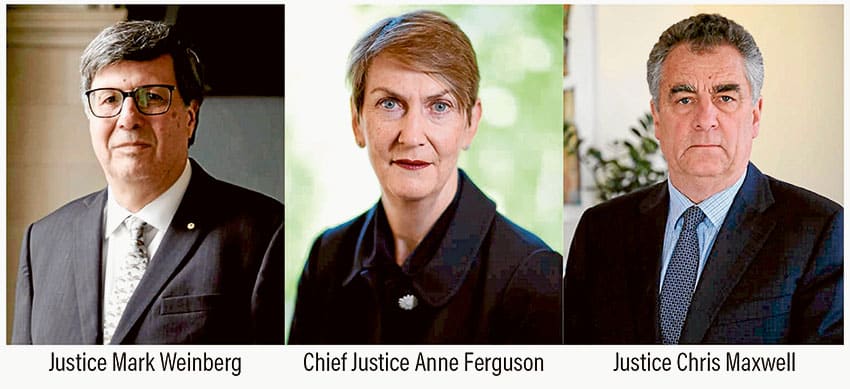
The Court of Appeal of the state of Victoria dismissed George Cardinal Pell’s appeal on Wednesday 21 August in Australia from his sexual abuse conviction.
That conviction came at the end of a second trial on five counts of indecency with a minor, after a first jury could not agree on a verdict.
He was sentenced to six years, without the possibility of parole until November, 2022. Cardinal Pell’s lawyers are yet to decide a further appeal to the Australian High Court. That process is likely to take up to a year. During the interim, the cardinal will remain in a Victorian prison.
Because the trials were conducted in closed sessions and under a press “gag” order, accounts of the evidence against the cardinal have been incomplete and even sketchy. Until now.
” … accounts of the evidence against the cardinal have been incomplete and even sketchy. Until now.”
It was long widely known that the case involved allegations of assaults on two choirboys, both aged 13 when the crimes supposedly occurred in late 1996.
The setting was said to be just after then-Archbishop Pell celebrated Mass at St Patrick’s Cathedral in Melbourne.
One of the boys died accidentally a few years ago. The surviving complainant said nothing to anyone of his horrendous story until 2015. (The other boy died without ever claiming to have been abused; in fact, he expressly denied that any such thing happened to him when his mother in 2001 pointedly asked him.)
Improbable allegations
It has long been apparent, too, that the allegations against Cardinal Pell were so inherently improbable as to be, on their face, almost fantastic. Nonetheless, the prosecutors pressed on. They finally got a jury to return the verdict they wanted.
Knowing the cardinal as I do, and evaluating the evidence reported in light of my years as a Manhattan trial prosecutor, I have always confidently believed that Cardinal Pell is innocent.
One small mercy of this unwelcome appellate setback is that I am now certain that Cardinal Pell is innocent.
After the appeal: how things look
Another consolation is that the appellate decision supplies reasonable grounds to hope that the High Court will finally correct this awful miscarriage of justice if the Cardinal seeks leave to appeal. The basis for affirming Cardinal Pell’s innocence lies in the evidence now recounted in extraordinary detail across the 325 pages of the appellate corpus.
The court split 2-1. The dissenting judge — an Oxford-educated lawyer named Mark Weinberg — never quite said that he believed that Cardinal Pell was innocent.
The closest Weinberg J came to saying so might be this sentence: “[T]o my mind, [there is] a ‘significant possibility’ that the applicant in this case may not have committed these offences.”
Reading between the lines
Perhaps Weinberg J came closer when he addressed the second of the two assaults alleged by the surviving claimant:
“The complainant’s account of the second incident seems to me to take brazenness to new heights, the like of which, I have not seen … I would have thought that any prosecutor would be wary of bringing a charge of this gravity against anyone, based upon the implausible notion that a sexual assault of this kind would take place in public, and in the presence of numerous potential witnesses.
“Had the incident occurred in the way that the complainant alleged, it seems to me highly unlikely that none of those many persons present would have seen what was happening, or reported it in some way.” None did. Weinberg J directed the reader to the next logical inference: If the complainant made up (for reasons we shall likely never know, or at least not ever fully understand) one of the two assaults, then no reasonable person should credit just on his say-so that the first incident ever occurred, either.
Yet that is exactly what the prosecutors maintained.
SPECIAL EDITION THIS CATHOLIC LIFE PODCAST
Justice Weinberg wrote, quite accurately, that the “prosecution relied entirely upon the evidence of the complainant to establish guilt, and nothing more.
“There was no supporting evidence of any kind from any other witness. Indeed, there was no supporting evidence of any kind at all. These convictions were based upon the jury’s assessment of the complainant as a witness, and nothing more.”
“Indeed,” Weinberg J added, the prosecutor not only “did not shrink” from making it his whole case at trial. The prosecutor “invited the members of this Court to approach this ground of appeal in exactly the same way.”
A strong dissenting voice
Justice Weinberg’s opinion is masterful and cogent. It supplies (though he did not expressly say it) overwhelming proof that George Pell is an innocent man.
There is another encouraging thought: The path to reversal on further appeal if pursued is now in view.
According to Australian procedure, much of the appellate judges’ job in a case such as Cardinal Pell’s (where the gravamen of the appeal is the sufficiency of the evidence to convict at the trial) is to simply use common sense to weigh the evidence presented to the jury.
This the three jurists did; the entire trial was videotaped and transcribed as well. Two members of the court said that they agreed with the jury’s verdict. So they voted to affirm the conviction.
Their common sense is obviously poor and their practical judgment, worse.
A simple mistake of this sort would probably not, however, warrant reversal by the High Court.
Legal error?
But they made a specifically legal error as well. On this ground at least one may reasonably hope that sometime within the next 12 months George Pell will be again a free man.
Justice Weinberg identified the majority’s mistake. Their error rested upon the two judges’ acceptance of the prosecutor’s invitation to decide first and in isolation — that is, without regard for all the other evidence, notably including the cogent exculpatory evidence offered by the Cardinal’s lawyers — whether the complainant’s testimony was “compelling.”
The term is not spot-on apt in this context. Hamlet is “compelling.” It is nonetheless fiction.
The majority judges seem to have adopted the term anyway as a synonym for not only believable, but for true, accurate.

Then these judges compounded the error: they used their isolated (and, in that sense, totally uncritical) validation of the complainant’s testimony as the criterion by which they rejected, as ineffectual or just plain false, the abundant evidence of Pell’s innocence.
They seemed to have reasoned thus: because the complainant’s story is true (we have concluded by, according to their own account, its apparent sincerity and drama), the evidence offered by the defendant which contradicts the complainant’s allegations must therefore be false.
Or, at a minimum, they judged that because the defence evidence did not demonstrate that the claimant’s story was simply impossible, it did not for that reason raise a reasonable doubt.
Justice Weinberg saw the mistake.
Weighing up witnesses
The complainant’s credibility and thus the accuracy of his story must instead be evaluated in light of the competing evidence of Cardinal Pell’s innocence.
He wrote that it “is, of course, entirely legitimate for the prosecution to [rely upon the complainant’s allegations] in answer to the challenge to these convictions.
“They must be weighed in the scale, but they must also be considered in the light of the evidence as a whole. That includes the body of clearly exculpatory material elicited from the various witnesses called by the prosecution.
“And one should not ignore the applicant’s own strong denials of any wrongdoing, as alleged, in his record of interview.”
In other words, a reasonable juror (and appellate judge!) would have to conclude that the defence case made the complainant’s story so implausible that a reasonable doubt was inescapably present.

A conscientious juror (or appellate judge sitting in review) must not conclude that a complainant is speaking truthfully until after he or she critically compares what that witness says to what the other witnesses say.
The critical evaluation incumbent on jurors is not the majority’s sequence — if looking only at the complainant’s testimony, it seems true, then all the evidence exonerating the Cardinal must be false — but rather Justice Weinberg’s dialectic (if you will), where the juror tacks back and forth across the evidence, using this bit to test the veracity of that, and that bit to evaluate the truthfulness of this.
That is simply what looking “at all the evidence” means. And herein is the majority’s legal mistake.
Put differently: The key issue on appeal was whether the jury’s verdict of guilty was reasonable.
Because the standard of proof in criminal cases in Australia is (as it is in America) “beyond a reasonable doubt,” there is some danger of confounding readers by using too many cognates of the word seeking definition — reason.
The plainest way to put the matter is probably this: Would a sensible, intelligent, conscientious juror who considered with an unbiased mind all of the evidence have to have a “reasonable doubt” about the Cardinal’s guilt?
Sufficient doubt
That doubt would be sufficient to require an acquittal if it attached to even just one essential element of the offenses charged.
Justice Weinberg concluded that, “in my respectful opinion, these convictions cannot be permitted to stand. The only order that can properly be made is that the applicant be acquitted on each charge.”
Indeed. And so one hopes, and perhaps dares to expect, the Australian High Court to conclude as well, some months from now.
Related articles
